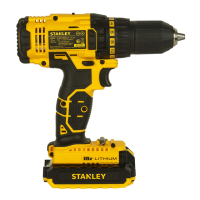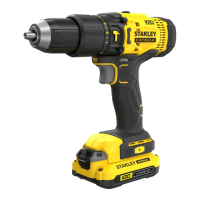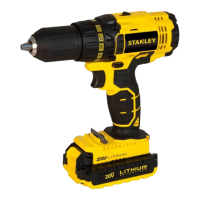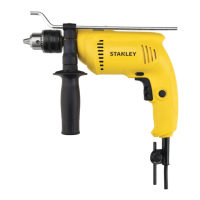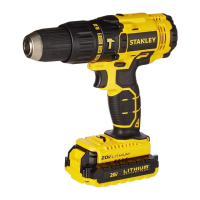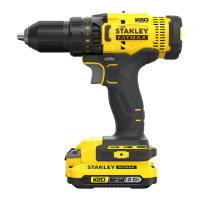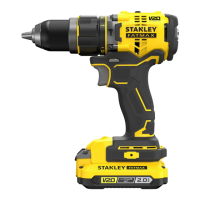LEAVING THE BATTERY IN THE CHARGER
The charger and battery pack can be left connected with
the LED glowing indefinitely. The charger will keep the
battery pack fresh and fully charged. This charger features
an automatic tune-up mode which equals or balances the
individual cells in the battery pack to allow it to function at
peak capacity. Battery packs should be tuned up weekly or
whenever the battery no longer delivers the same amount of
work. To use the automatic tune-up mode, place the battery
pack in the charger and leave it for at least 8 hours.
IMPORTANT CHARGING NOTES
1. Longest life and best performance can be obtained if
the battery pack is charged when the air temperature
is between 65°F and 75°F (18°C - 24°C). DO NOT
charge the battery pack in an air temperature below
+40°F (+4,5°C), or above +105°F (+40,5°C). This
is important and will prevent serious damage to the
battery pack.
2. The charger and battery pack may become warm to
touch while charging. This is a normal condition, and
does not indicate a problem. To facilitate the cooling of
the battery pack after use, avoid placing the charger or
battery pack in a warm environment such as in a metal
shed, or an uninsulated trailer.
3. If the battery pack does not charge properly:
a. Check current at receptacle by plugging in a lamp or
other appliance.
b. Check to see if receptacle is connected to a light switch
which turns power off when you turn out the lights.
c. Move charger and battery pack to a location where the
surrounding air temperature is approximately 65°F -
75°F (18°C - 24°C).
d. If charging problems persist, take the tool, battery pack
and charger to your local service center.
4. The battery pack should be recharged when it fails to
produce sufficient power on jobs which were easily
done previously.
5. DO NOT CONTINUE to use under these conditions.
Follow the charging procedure.
6. You may also charge a partially used pack whenever
you desire with no adverse affect on the battery pack.
OPERATING INSTRUCTIONS
Installing and removing the battery pack from the
tool.
CAUTION! Make certain the lock-off button is engaged
to prevent switch actuation before removing or installing
battery.
To install battery pack (Fig. B)
♦ Insert battery pack firmly into tool until an audible click
is heard. Ensure battery pack is fully seated and fully
latched into position.
Note: Make sure that the battery pack is firmly seated
in place.
To remove battery pack (Fig. C)
♦ Depress the battery release button (7) and pull battery
pack out of tool.
Drilling
♦ Use sharp drill bits only.
♦ Support and secure work properly, as instructed in the
Safety Instructions.
♦ Use appropriate and required safety equipment, as
instructed in the Safety Instructions.
♦ Secure and maintain work area, as instructed in the
Safety Instructions.
♦ Run the drill very slowly, using light pressure, until the
hole is started enough to keep the drill bit from slipping
out of it.
♦ Apply pressure in a straight line with the bit. Use enough
pressure to keep the bit biting but not so much as to stall
the motor or deflect the bit.
♦ Hold the drill firmly with two hands, one hand on the
handle, and the other gripping the bottom around the
battery area or the auxiliary handle if provided.
♦ Do not click the trigger of a stalled drill off and on in an
attempt to start it. Damage to the drill can result.
♦ Minimize stalling on break through by reducing pressure
and slowly drilling through the last part of th hole.
♦ Keep the motor running while pulling the bit out of a
drilled hole. This will help reduce jamming.
♦ Make sure switch turns drill on and off.
LED work light
When drill is activated by pulling the trigger switch (1), the
integrated LED work light (8) will automatically illuminate
the work area.
Note: The work light is for lighting the immediate work
surface and is not intended to be used as a flashlight.
Bit tip storage
A bit storage slot (9) is built into the base of the tool.
Trigger switch & forward/reverse button (FIG. D)
♦ The drill is turned ON and OFF by pulling and
releasing the trigger switch (1) shown in figure C.
The farther the trigger is depressed, the higher the
speed of the drill.
♦ A forward/reverse control button (2) determines the
rotational direction of the tool and also serves as a lock
off button.
♦ To select forward rotation, release the trigger switch and
depress the forward/reverse control button on the right
side of the tool.
♦ To select reverse, depress the forward/reverse control
button on the left side of the tool.
♦ The center position of the control button locks the tool
in the off position. When changing the position of the
control button, be sure the trigger is released.
Adjusting torque control (FIG. E)
This tool is fitted with a torque adjustment collar (3) to select
the operating mode and to set the torque for tightening
screws. Large screws and hard workpiece materials
require a higher torque setting than small screws and soft
workpiece materials.
